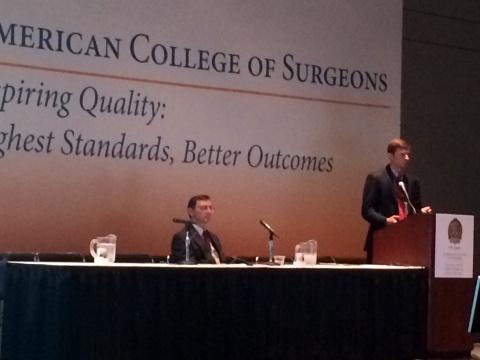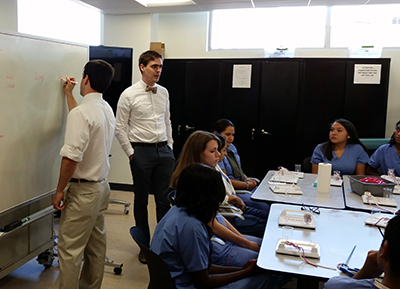
Photo: Trey Sinyard (MS3) presenting the Duke General Surgery Interest Group’s initiatives and progress as part of a podium presentation at the 2016 American College of Surgeons Clinical Congress in Chicago
The life of a medical student is that of long days studying medicine, sleepless nights spent tirelessly working away, all while juggling one’s professional and personal life. With all the time and effort involved, it is a surprise that medical students are able to spend their time doing anything else. And yet, that is exactly what many of Duke’s medical students are doing, specifically the officers behind the Duke General Surgery Interest Group (GSIG).
The Duke GSIG is an organization that works in conjunction with the Duke Department of Surgery to foster interest in general surgery. The group holds workshops, discussions, and case studies, and provides students with research and mentorship opportunities. The entire organization is student-run, with six medical students at its helm.
“We have a mission statement, which is to stimulate interest in surgery among all Duke medical students, and to specifically get students to apply into general surgery residency programs when they have finished medical school,” says Trey Sinyard, a third-year medical student from Athens, Georgia, on a dual-degree track with the Fuqua Business School. Sinyard plans to go into trauma surgery, critical care, and surgical oncology.
“Medical students often do not get exposure to general surgery until later in their career. So by virtue, you lose some of that interest you can generate when students first come in. We thought it would be very important to get students when they first arrived to campus to build as much of that energy as we could,” adds Harold Leraas, a third-year medical student from Olympia, Washington, who plans to go into pediatric general surgery.
The group’s mission is threefold: (1) promote interest in surgical careers (2), serve the community, and (3) expand students’ knowledge by building on medical curriculum. This past year, new initiatives have arisen to further the mission’s goal.

“Most of the GSIG initiatives are brand new, but they are still well funded and appreciated by the Department of Surgery,” Sinyard explains. These new initiatives include an education outreach program at two local high schools. GSIG members volunteer their time to teach high school students who are interested in medicine, helping them learn an array of skills, including the basics of anatomy and how to diagnose patients. The outreach program offers medical students a unique opportunity to serve the community while developing their teaching skills. The program has been a tremendous success. In October 2015, members of the GSIG flew to Chicago to discuss the program’s findings at the American College of Surgeons (ACS) Clinical Congress.
The GSIG has also recently introduced a program that brings medical students and residents together for dinners so students have an opportunity to interact with and learn from residents.
“I cannot speak highly enough about how the residents have taken time out of their own schedules to be involved,” says Sinyard. The relationships fostered with residents act both as a form of mentorship and as a way to dispel many preconceived notions that medical students may have about a surgeon’s lifestyle, such as being too overwhelming and all-consuming to have a life outside of medicine. Therefore, along with teaching students about the technical side of surgery, the GSIG aims to combat surgeon stereotypes, allowing students to realize they do not have to conform to a particular trope to succeed. These interactions allow medical students to see surgeons as regular people — people with hobbies, interests, and passions like any other person.
“We have a mission statement, which is to stimulate interest in surgery among all Duke medical students, and to specifically get students to apply into general surgery residency programs when they have finished medical school.”
-Trey Sinyard, third-year medical student
The greatest goal of the GSIG is to spark students’ interest in general surgery by providing more exposure to surgery than what is typically included in the medical school curriculum. As Sinyard explains, the initial interest in surgery among medical students wanes over time. “We thought that was an unfair judgment of surgery because students only received 8 weeks of very condensed, very hard work during their second year of medical school. We thought that if we could stretch the exposure of surgery into first and second year, students could make better decisions about whether surgery is for them.”
To assist students in their surgery curriculum and to cultivate greater interest in surgery, the GSIG developed a background curriculum to accompany their normal anatomy dissection. The curriculum is intended to complement the knowledge they will need during surgical rotations.
This curriculum initiative was popular among medical students, with over half of the first-year class participating in this completely optional program. The GSIG hopes that programs like these will allow medical students to be better prepared for being a surgeon, and give them the tools necessary to thrive.
As for the future of the GSIG, Sinyard and Leraas agree they hope to see the programs continue to expand. They are also looking to eventually create an educational model for other institutions that may be having difficulties recruiting students to surgical careers.
“I would love for this to be a launching pad to engage residents and attendees so that you are plugged into that community long before you consider a surgical career,” says Sinyard.
The pair also mentions how fantastic the support has been from the Department of Surgery.
“I think this group, in particular, has been very engaged and have revived the General Surgery Interest Group,” says Ranjan Sudan, MD, Vice-Chair of Education for the Department of Surgery, who has assisted in fostering GSIG’s growth. “They have great ideas, great energy, and the Department of Surgery has in turn helped them with either finances, funding, and direction -- it has been a really positive, mutual relationship.”
Adds Sinyard, “We are really blessed to have the backing of the Department of Surgery.”